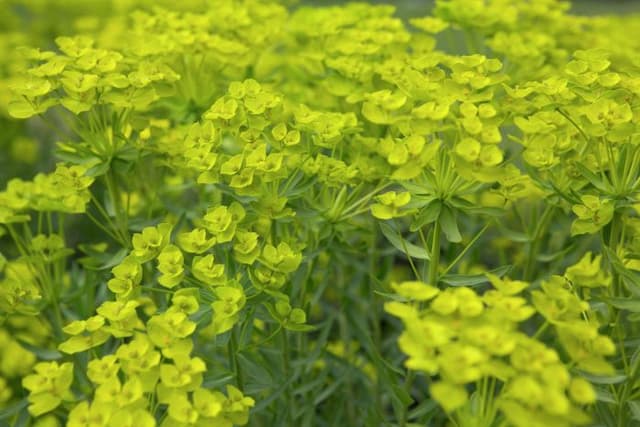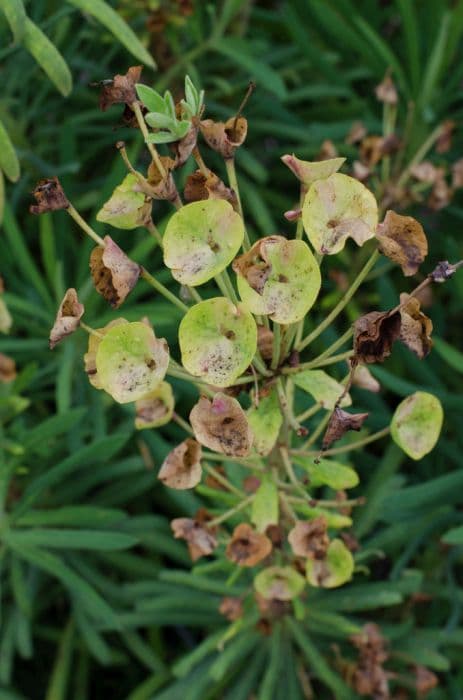Gopher Plant Euphorbia rigida

ABOUT
The plant commonly known as Gopher Spurge or Silver Spurge has a striking appearance that is both architectural and ornamental. The leaves of this plant are narrow and pointed, arranged in a spiral fashion around the stems, which gives it a bushy and textured look. These leaves often have a blue-green or gray-green color, with a waxy surface that reflects light, giving the plant a silver sheen. As the seasons change, the foliage can also take on a reddish or purplish tinge, adding to its visual appeal. Gopher Spurge produces bright yellow-green flowers that are small and inconspicuous on their own but are clustered in dense, rounded groups at the ends of the stems. These flower clusters are surrounded by showy, yellow bracts that look like petals, which are what really catches the eye and gives the plant its decorative look. This plant has a sprawling habit, with stems that can grow outwards from the center, creating a dense mound. The overall form is upright and somewhat dome-shaped, which makes it suitable for use in rock gardens or as a border plant. The contrasting textures and colors of Gopher Spurge's foliage and flowers, combined with its distinctive growth form, make it a unique and attractive addition to any garden setting.
About this plant
 Names
NamesFamily
Euphorbiaceae
Synonyms
Gopher Plant, Silver Spurge, Upright Myrtle Spurge, Rigid Spurge
Common names
Galarhoeus rigidus, Tithymalus rigidus, Euphorbia biglandulosa.
 Toxicity
ToxicityTo humans
Euphorbia rigida, commonly known as Gopher Spurge or Upright Myrtle Spurge, is toxic to humans. All parts of the plant contain a white, milky sap known as latex, which is highly irritating to skin and mucous membranes. If ingested, the sap can cause severe pain in the mouth and throat, nausea, vomiting, and diarrhea. If the sap comes into contact with skin, it can cause redness, swelling, and blisters. The most serious risk is if the sap enters the eyes, which can lead to temporary or permanent blindness. Therefore, caution is advised when handling this plant, and protective clothing, including gloves and eye protection, should be worn.
To pets
Gopher Spurge, or Upright Myrtle Spurge, exhibits toxicity to pets as well. The white milky sap that it secretes contains skin and mucous membrane irritants. If a pet licks or ingests any part of the plant, they may exhibit symptoms such as excessive drooling, vomiting, diarrhea, or pawing at the mouth due to irritation. If the latex comes into contact with the pet's skin, it can cause dermatitis or other skin irritations. Care should be taken to prevent pets from accessing this plant, especially since they might not be able to avoid the consequences of exposure as well as humans.
 Characteristics
CharacteristicsLife cycle
Perennials
Foliage type
Evergreen
Color of leaves
Blue-green
Flower color
Yellow
Height
2 feet (0.61 meters)
Spread
3 feet (0.91 meters)
Plant type
Shrub
Hardiness zones
8
Native area
Mediterranean
Benefits
 General Benefits
General Benefits- Drought Tolerance: Euphorbia rigida is highly drought-resistant, making it suitable for xeriscaping and low-water gardens.
- Low Maintenance: This plant requires minimal care once established, needing little to no supplemental watering or fertilizing.
- Erosion Control: The robust root system of Euphorbia rigida can help stabilize soil and prevent erosion on slopes.
- Attracts Pollinators: The flowers of the plant attract beneficial insects such as bees, which are important for pollination.
- Architectural Interest: With its rigid, upright growth habit and blue-green foliage, this plant adds structural interest to garden designs.
- Seasonal Interest: Euphorbia rigida provides year-round interest, with attractive foliage, winter flowers, and decorative seed pods.
- Durability: It's able to withstand harsh conditions, including poor soils and reflected heat from urban settings.
 Medical Properties
Medical PropertiesThis plant is not used for medical purposes.
 Air-purifying Qualities
Air-purifying QualitiesThis plant is not specifically known for air purifying qualities.
 Other Uses
Other Uses- Euphorbia rigida can be used as a natural barrier due to its rigid and spiky structure, which can deter animals and unauthorized people from entering certain areas.
- The sap of Euphorbia rigida, which is quite sticky, has been traditionally used for setting small traps for insects.
- The plant's drought-resistant nature allows it to be used for xeriscaping, a landscaping method that reduces the need for irrigation.
- Euphorbia rigida can be planted along slopes or banks for erosion control, as its root system helps to stabilize the soil.
- The plant’s striking foliage and architectural form can be used in garden design to create contrast and interest in rockeries or gravel gardens.
- The dried stalks of Euphorbia rigida can be used in floral arrangements and craft projects as they maintain their form and color for a long time.
- The seeds of the plant are a food source for birds, making Euphorbia rigida a good choice for a wildlife garden.
- In colder climates, Euphorbia rigida can be grown in containers and moved indoors during winter months to serve as an unusual houseplant.
- Its ability to grow in poor soils makes Euphorbia rigida a useful plant for reclaiming and vegetating disturbed land areas.
- The plant’s distinct appearance is sometimes used in film and theater productions as a prop to create an exotic, alien, or desert-like setting.
Interesting Facts
 Feng Shui
Feng ShuiThe Euphorbia rigida, commonly known as Gopher Plant, is not used in Feng Shui practice.
 Zodiac Sign Compitability
Zodiac Sign CompitabilityThe Gopher Plant is not used in astrology practice.
 Plant Symbolism
Plant Symbolism- Resilience: Euphorbia rigida, commonly known as gopher plant or silver spurge, is known for its ability to thrive in harsh, arid environments, which symbolizes the capacity to endure difficult circumstances and bounce back from challenges.
- Protection: The gopher plant produces a toxic sap that can deter herbivores and irritate human skin, symbolizing defense and the need to protect oneself from harm.
- Adaptability: As a plant that can adapt to a wide range of soil types and conditions, gopher plant represents flexibility and the ability to adjust to changing situations.
 Water
WaterGopher Spurge, also known as Euphorbia rigida, should be watered deeply but infrequently, as it is drought-tolerant. During the growing season in spring and summer, water approximately once every two weeks, using about 1 gallon of water per plant to ensure deep soil moisture. Reduce watering in the fall and throughout winter to once a month or less, depending on the weather conditions, as the plant requires a dry dormancy period.
 Light
LightGopher Spurge thrives in full sunlight. The ideal spot for this plant is an area where it can receive at least six hours of direct sunlight daily. Avoiding deep shade is crucial for the plant to grow healthily and produce its characteristic colorful bracts.
 Temperature
TemperatureGopher Spurge is quite hardy and can tolerate a range of temperatures, from around 25 to 80 degrees Fahrenheit. However, the ideal temperature range for optimal growth is between 50 and 70 degrees Fahrenheit. It should be protected from extreme cold, as temperatures below 25 degrees Fahrenheit may damage or kill the plant.
 Pruning
PruningPrune Gopher Spurge to maintain its shape and remove spent flowers to encourage new growth. Pruning is best done in late winter or early spring, before the new growth begins. This typically needs to be done once a year to keep the plant looking tidy.
 Cleaning
CleaningAs needed
 Soil
SoilGopher spurge, commonly known as Euphorbia rigida, thrives best in a well-draining soil mix composed of sand, loam, and gravel or perlite. The ideal soil pH should be neutral to slightly alkaline, ranging between 6.0 and 7.5. A cactus or succulent-specific potting mix can also serve as a suitable base for this drought-tolerant plant.
 Repotting
RepottingGopher spurge should typically be repotted every two to three years to refresh the soil and accommodate root growth. It’s important not to repot too frequently, as this plant prefers not to be disturbed often. Wait until the plant has outgrown its current pot or the soil has depleted before attempting to repot.
 Humidity & Misting
Humidity & MistingGopher spurge is tolerant of a wide range of humidity conditions and does best in low to average humidity environments. It is well-suited to arid climates and does not require high humidity to thrive.
 Suitable locations
Suitable locationsIndoor
Keep gopher spurge in bright light, well-draining soil, minimal water.
Outdoor
Plant gopher spurge in full sun, well-drained soil, water sparingly.
Hardiness zone
7-11 USDA
 Life cycle
Life cycleEuphorbia rigida, commonly known as gopher plant or silver spurge, begins its life cycle with seed germination, which occurs in warm, damp soil conditions. The seedling stage follows, characterized by the emergence of cotyledons and the development of the plant’s first true leaves and root system. In the vegetative stage, the gopher plant experiences a period of rapid growth, with the development of its characteristic silver-blue foliage and robust, woody stems. Once mature, typically in early spring, Euphorbia rigida enters the flowering stage, producing small yellow-green flowers surrounded by long-lasting, showy bracts that attract pollinators. After pollination, the plant sets seed within three-lobed capsules that explode when ripe, dispersing the seeds for the next generation. Throughout its life cycle, the gopher plant may experience multiple flowering and seeding events, with individual plants able to live for several years under the right conditions.
 Propogation
PropogationPropogation time
Spring-Early Summer
For Euphorbia rigida, commonly known as Gopher Spurge or Silver Spurge, the most popular method of propagation is through seed sowing. The best time to propagate is in spring after the danger of frost has passed. To propagate from seeds, collect them once the seed pods have dried on the plant, which typically occurs in late summer or early autumn. Sow the seeds in a well-draining soil mix, covering them with a thin layer of soil about 1/4 inch (about 6 millimeters) deep. Keep the soil moist but not waterlogged, and in a warm, bright location without direct sunlight. Germination should occur within a few weeks, depending on temperature and other environmental factors. Once the seedlings are large enough to handle and have developed true leaves, they can be transplanted into individual pots or their final location in the garden.









